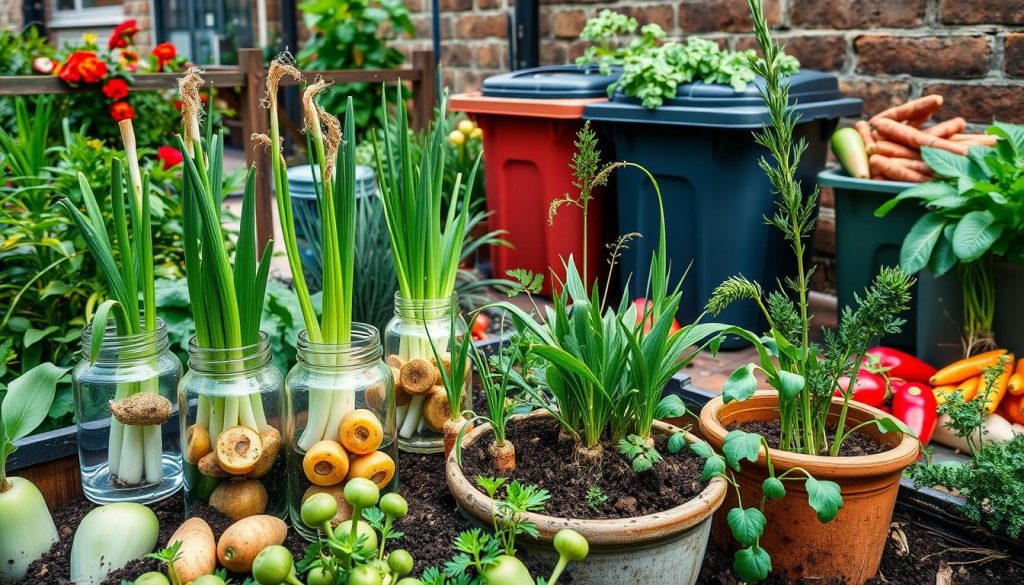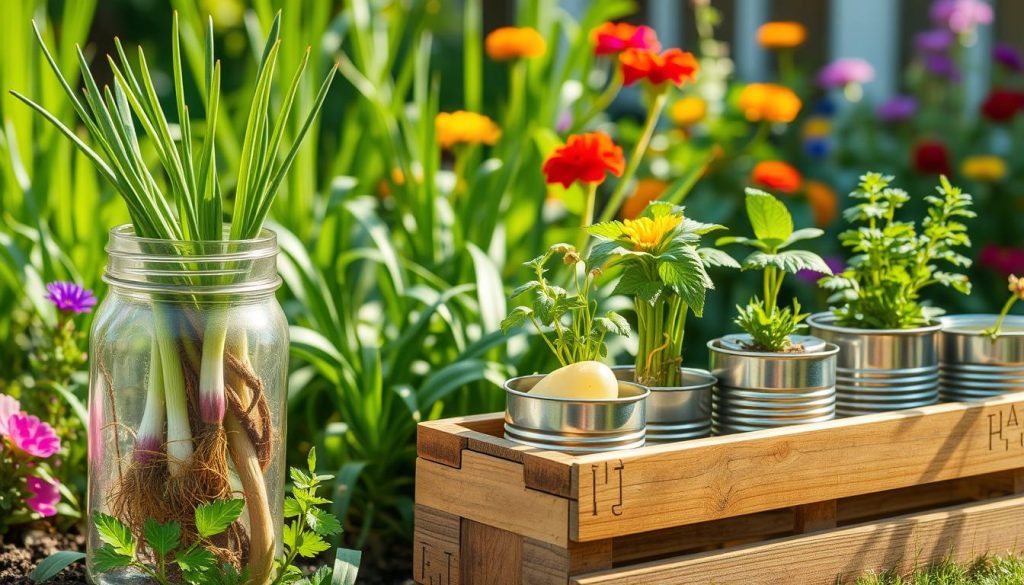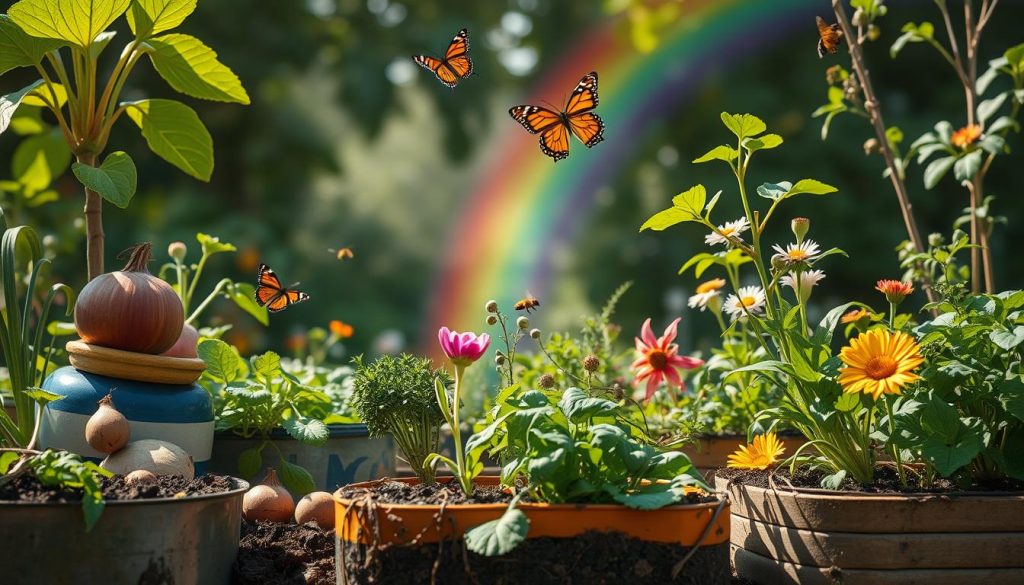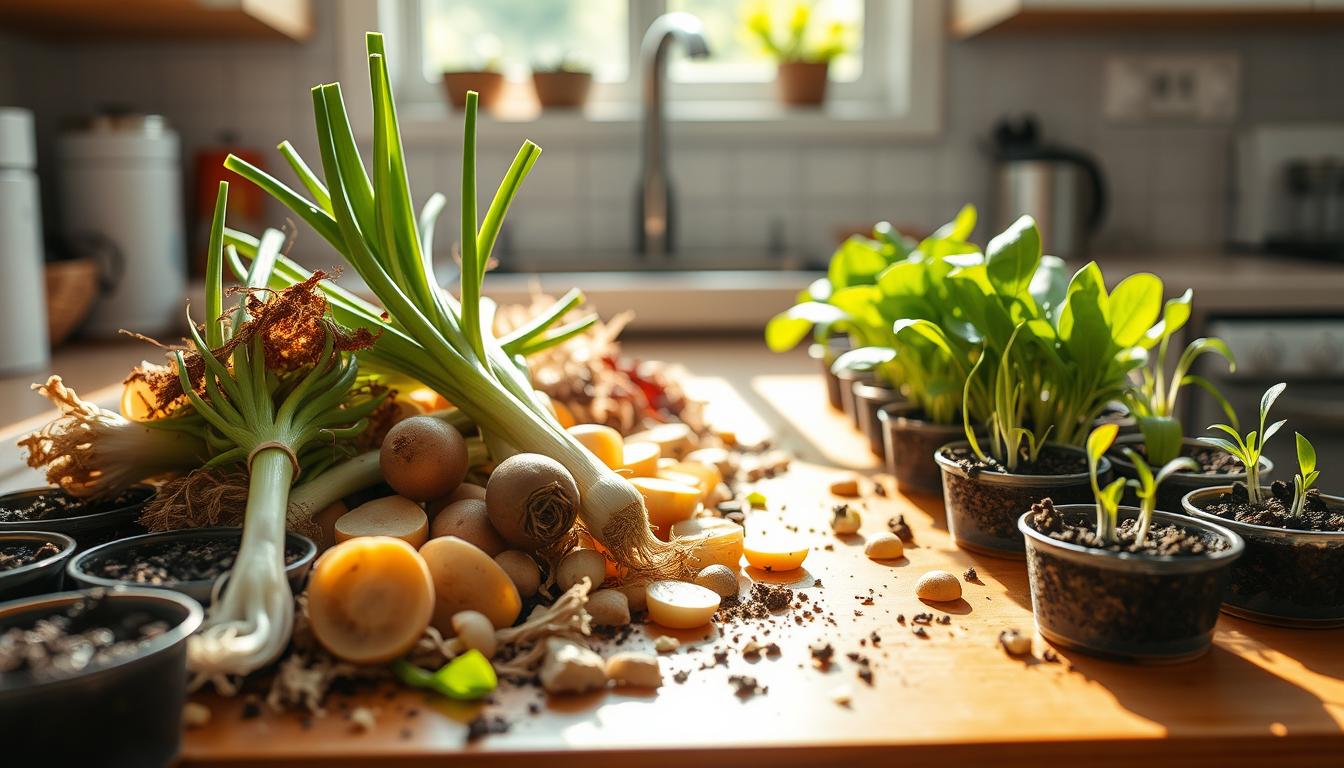I’m excited to share my journey of growing plants from food scraps. It’s a simple way to cut down on waste and enjoy fresh food. By regrowing veggies, we can help the planet and live greener.
This method has cut down my waste and given me fresh food at home. I’ll talk about the good things about growing plants from scraps. I’ll also share which scraps work best and how to do it step by step. This way, anyone can start and enjoy the perks of this green habit.
Why I Started Growing Plants from Food Scraps
I noticed how much waste I was throwing away in my kitchen. I wanted to do something about it. I started looking into kitchen scraps gardening and fell in love with it. It’s a way to live more sustainably and grow my own food.
Using kitchen scraps to grow plants is great for the planet. It also lets me grow my own food and connect with nature. I’ve learned so much about reducing waste and living sustainably. I’m excited to share what I’ve learned with others.
My Motivation
I started this journey because I wanted to help the environment. By growing my own food and reducing waste, I’m making a difference. Kitchen scraps gardening is a fun hobby that lets me enjoy fresh, homegrown produce.
How Sustainable Living Attracted Me
Sustainable living drew me in because it’s about living in harmony with nature. By gardening sustainably, I’m reducing my need for industrial farming. I believe we can all make a difference by making small changes. I hope to inspire others to join me.
- Reduce waste by using kitchen scraps to grow plants
- Grow my own food and enjoy the benefits of fresh, homegrown produce
- Connect with nature and live a more sustainable lifestyle
The Types of Food Scraps I Use
Exploring food waste gardening, I found many food scraps useful for growing plants. This method cuts down on waste and supports a green food system. It’s a natural and friendly way to garden.
Vegetable Scraps
Carrot tops, onion peels, and potato skins can grow into new plants. Just plant them in soil and care for them. Soon, you’ll have fresh veggies.
Herb Scraps
Herbs like basil, mint, and cilantro can grow from scraps. Plant them in soil and enjoy fresh herbs in weeks. It’s a smart, green way to garden.
Fruit Scraps
Lemon seeds, orange peels, and apple cores can start fruit trees. It takes longer than veggies or herbs, but it’s rewarding. It helps plants grow and cuts down on waste.

Using food scraps for gardening helps the planet and supports a green food system. It’s a great way to grow plants and reduce waste in our communities.
Step-by-Step Guide to Regrowing Veggies
Regrowing veggies is easy and rewarding. It requires little equipment and care. By using eco-friendly gardening, we help the environment and get fresh produce at home.
To start, we need to know how to regrow different veggies. For root veggies like carrots and beets, here’s what to do:
- Cut off the tops, leaving about an inch of the stem intact
- Place the cut ends in a container of water or soil
- Wait for them to regrow, making sure to provide adequate water and light
For leafy greens like lettuce and spinach, it’s even easier. Just put the leaves in water or soil and wait for them to grow back. Eco-friendly gardening and organic plant propagation help our gardens thrive for years.
By following these steps and using eco-friendly gardening, we can enjoy a lot of fresh, tasty veggies. This also helps the environment. Whether you’re new to gardening or experienced, regrowing veggies is a great way to help the planet.
Tricks for Successful Regrowth
Exploring upcycled gardening, I’ve found that regrowth needs focus and a few tricks. Watering is key. Too much water harms plants, while too little slows them down.
Optimal Watering Techniques
I water my plants often but avoid too much. A good potting mix helps prevent soggy soil. This method works well for growing plants from scraps, controlling water intake.
Light Requirements
Light is vital for plants to grow back. I put them near a sunny window or use grow lights. This gives them the light they need without burning them.
Soil Considerations
Soil matters a lot for growth. I use a mix that drains well and is rich. It’s perfect for upcycled gardening and growing plants from scraps.
These tips help me grow many plants from scraps. It’s a way to reduce waste and live sustainably. Upcycled gardening is great for anyone wanting to help the environment.

Common Mistakes to Avoid
Regrowing vegetables from kitchen scraps can be tricky. There are a few common mistakes to watch out for. These mistakes can harm our plants’ health and growth. Knowing them helps us grow healthy plants.
One big mistake is overwatering. It can cause root rot and other issues. Regrowing vegetables need the right balance of water and nutrients. Another mistake is not controlling pests, which can damage our plants.
Overwatering Dangers
Overwatering is a common error. We can avoid it by checking the soil moisture and adjusting our watering. It’s crucial to keep the soil just right for our plants to absorb nutrients well.
Ignoring Pest Control
Not controlling pests is another big mistake. It can harm our plants a lot. By using natural pest control or introducing beneficial insects, we can protect our plants. Avoiding these mistakes lets us enjoy the benefits of kitchen scraps gardening, like reducing waste and getting fresh produce.
By avoiding these mistakes, we can create a thriving garden. It gives us fresh produce and helps the environment. Whether you’re new to gardening or experienced, regrowing vegetables is a great way to start and make a difference.
The Benefits of Home-Grown Plants
Growing my own plants from food scraps has many benefits. One big plus is the taste and freshness of my home-grown food. Harvesting at the right time means my meals are more flavorful and healthy.
Practicing sustainable gardening, like using food waste, is good for my health and the planet. It helps me use less energy and supports a greener food system.
Freshness and Flavor
Some key benefits of growing my own plants include:
- Fresher produce, which tastes better and is more nutritious
- Cost savings, since I don’t buy as much from stores
- A sense of pride and accomplishment in growing my own food
Cost Savings
Using sustainable gardening methods like food waste gardening saves me money. It also helps cut down on food waste, a big issue worldwide.

Sharing My Success Stories
I’m thrilled to share my journey of growing plants from food scraps. I’ve learned a lot about plant regeneration and eco-friendly gardening. These practices have made my garden sustainable and thriving.
Seeing my first harvest was incredibly rewarding. It shows how plants can grow with little effort, given the right conditions. Eco-friendly gardening has also cut down my carbon footprint. Plus, I get to enjoy fresh, healthy food right in my backyard.
First Harvest Experiences
My first harvest was exciting. I grew herbs and veggies from food scraps that would’ve been thrown away. This taught me the importance of reducing waste and living sustainably.
Recipes Using Home-Grown Produce
I’ve made many recipes with my home-grown produce. From salads to soups, the options are endless. Using plant regeneration and eco-friendly gardening has made my life more sustainable and self-sufficient.
- Reduced carbon footprint
- Increased crop yields
- Improved soil health
- Conservation of water
By following these practices, we can help plants regenerate. This creates a better future for us and our children.
Final Thoughts on This Sustainable Habit
Reflecting on growing edible plants from food scraps, I feel accomplished and excited. Organic plant propagation has changed how I see food and gardening. It’s not just about reducing waste; it’s about appreciating nature’s growth cycles.
Encouragement to Others
I urge everyone to try upcycled gardening. It’s a simple way to help the environment, save money, and enjoy fresh produce. With patience and the right skills, you can turn food scraps into healthy plants.
Future Plans for Expanding My Garden
I’m looking forward to growing my garden more and finding new ways to use waste. I want to learn and try new things to grow different edible plants. My dream is to inspire others to join this green and healthy journey.

